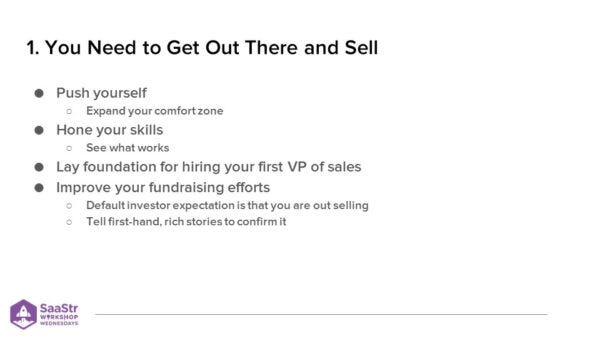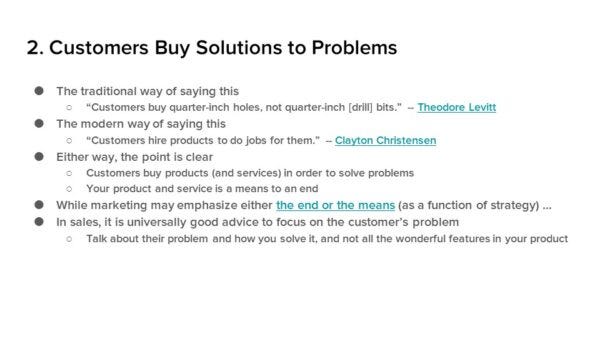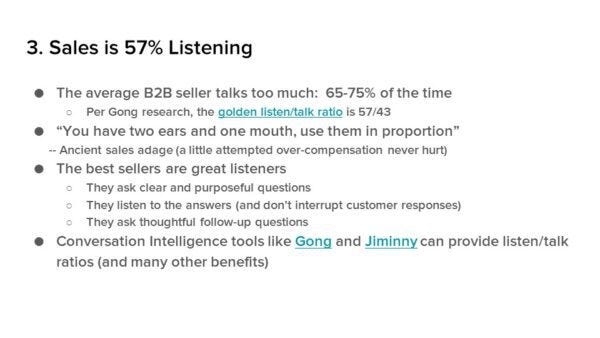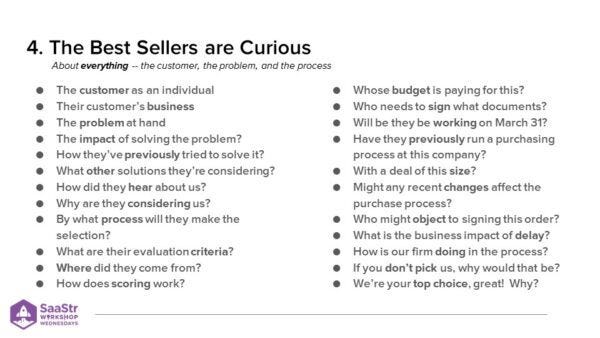One of the most essential things SaaS founders need to get right is their sales strategy. From day one, it’s critical to drive results to impress your investors, acquire customers, and set your sales team up for success.
Dave Kellogg –– ex-CEO of Host Analytics, Consultant, EIR at Balderton Capital, and author of the Kellblog –– knows a thing or two about successful sales. In an in-depth workshop, Kellogg shares seven things that every founder should know about results-driven selling.
SaaStr Workshop Wednesdays are LIVE every Wednesday. Sign up for free.
#1 You Need to Get Out There And Sell
Sometimes, the best way to learn is by doing. As a founder, it’s vital for you to be a big part of sales, especially in the early stages of your company. Even if it isn’t in your comfort zone, it’s a good idea to push yourself and have those conversations with real prospective buyers. Getting on sales calls early lets you see what works well with customers and helps you lay the strategic foundation for your first VP of Sales.
Kellogg says, “Get out there on sales calls and/or just listen to them en masse because sales calls are where corporate pitchmanship meets field reality.” Marketers must listen in on sales calls, too, because it can reveal whether the brand message really resonates with the customer or if it addresses their interests and pain points.
#2 Customers Buy Solutions to Problems
Kellogg reveals that your prospect’s mindset requires a different approach than we may assume: “A lot of salespeople think that customers buy products, and the answer is no, they don’t –– they buy a solution to a problem.” Your customers are paying for a problem to go away, and your product is a means to an end. While marketing might focus on both the end and the means as a part of a strategy, a seller needs to emphasize how to solve a customer pain point.
This concept can be challenging to work with if you are a platform seller instead of an app seller. It feels more natural to sell an app since it solves a specific problem, while a platform has many features and uses.
*A word about category creation: If your startup is creating a new category, your initial objective will be to get the word out and explain to customers why they need your product and what problems it can solve. But you must be ready for an inevitable pivot in messaging. Eventually, the conversation will shift: Customers in the market for your category will come to you and want to know why your product is the best one to buy.
#3 Sales is 57% Listening
Did you know that the average B2B seller talks too much? It’s been estimated that a sales rep on a B2B call will speak about 65 – 75% of the time. However, Gong research suggests that the golden listen/talk ratio is 57/43.
The best sellers are very skilled listeners, and they do the following three things:
They ask clear and purposeful questions.
They listen to the answers and don’t interrupt customer responses.
They ask thoughtful follow-up questions.
If you don’t listen to your prospects, you risk losing out on deals or genuinely understanding their pain points. Try to give the buyer more opportunities to discuss their needs, describe their situation, and explain what they’re looking for in a product.
Pro Tip: Conversation intelligence tools like Gong and Jiminny can provide “listen/talk” ratios and other benefits.
#4 The Best Sellers are Curious
Cats and curiosity may not mix, but a curious seller usually wins. Good sellers are curious about everything, including the customer and their business, the problem they are trying to solve, and the process of closing a deal. However, sales reps often neglect to ask about the customer’s closing process. As Kellogg says, “The part that many sellers get correct is to be curious about the problem. The part they’ll often miss is curiosity about the process.”
Why is this important? Understanding how the process and typical operations at a prospect’s organization helps avoid surprises at deals being delayed, hitting roadblocks, or falling through based on information gaps.
Examples of process-oriented questions to ask:
Whose budget is paying for this?
Might any recent changes affect the purchase process?
Who needs to sign off?
Who might object to signing this order?
What is the evaluation criteria?
#5 The Best Sellers Ask Open-Ended Questions
Open-ended questions generally reveal far more information than closed-ended ones –– and produce a conversation instead of an interrogation. In the examples below, consider how the same type of questions can further a dialogue when asked in an open-ended way.
Your sales teams must practice keeping an open conversation with this question structure. Keep in mind learning to do this is challenging –– so go slow, be intentional, and keep trying.
#6 Manage the Sales Process as a Quid Pro Quo
It can seem natural for a salesperson to jump through hoops to close a deal, and that effort is a good thing. However, remember, a prospect may or may not choose to buy your software. And your company’s investment of time and resources is real. For example, a cost of sales opportunity can run $2K – $4K in enterprise. And building a customer demo can cost $5K – $10K of a solution consultant’s time.
So, it’s a good idea to maintain a balance of power in the relationship by getting in the habit of asking about “give/gets” (i.e., “If I give X, can I get Y?”). Here are some examples of how a sales rep might word this:
If you spend two hours with us on requirements, we can build a customized demo.
If we build the customized demo, will the CFO come?
If we run a one-hour ask me anything, can we meet the CDO afterward?
#7 Don’t Talk About the Competition Unless Asked
Your company may invest a lot of time understanding the competitive offerings and why you’re superior to them. But that doesn’t mean you need to directly verbalize those points to a buyer. In fact, there are many risks if you talk about the competition in selling –– e.g., you can:
Accidentally introduce a competitor into a deal.
Appear competitor-focused, not customer-focused.
Seem afraid, or give the impression that the competitor is the real market leader.
Stop getting invited on sales calls.
If you need to mention other vendors during a sales call, keep these three rules in mind:
Generally, don’t do it –– have a mental yellow flag up for every second you’re doing it.
Be sure everything you say is true and defensible –– credibility is critical.
Only say the name of a competitor when it’s been mentioned to you first –– avoid accidental intros.
Key Takeaways
A good seller will listen more than they speak, and they will ask open-ended questions.
Remember, it costs time and resources to close a deal. Your time is valuable, so be sure you’re maintaining a balanced sales-client relationship.
Avoid mentioning competitors during a sales call unless directly asked –– you may inadvertently lose the deal.





